Home / Reactions of Grignard Reagents
Organometallics
Reactions of Grignard Reagents
Last updated: February 5th, 2025 |
All About The Reactions of Grignard Reagents
- Grignard reagents are excellent carbon-based nucleophiles as well as strong bases.
- They will add to aldehydes and ketones to form alcohols (after a protonation step)
- They will add twice to esters to give tertiary alcohols.
- They will add to the less-substituted side of epoxides
- Grignard reagents will also react with carbon dioxide (CO2) to give carboxylic acids (after acid workup).
- Grignard reagents will not perform SN2 reactions with alkyl halides. They are also not compatible with carboxylic acids or alcohols.
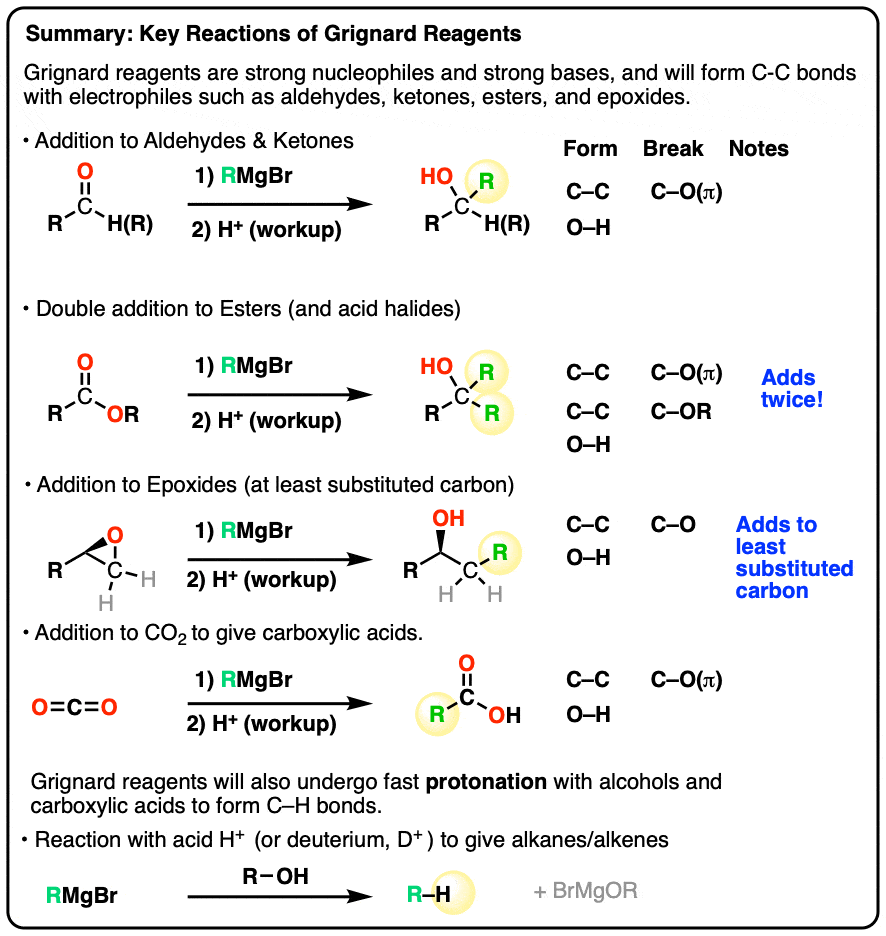
Table of Contents
- Reminder: Grignard Reagents Are Nucleophiles
- Addition of Grignard Reagents To Epoxides
- Reaction of Grignard Reagents With Aldehydes And Ketones
- Reaction of Grignard Reagents With Esters
- Why Do Grignards Add Twice To Esters? The Mechanism
- Summary: Reactions of Grignard Reagents
- Notes
- Quiz Yourself!
- (Advanced) References and Further Reading
1. Reminder: Grignard Reagents Are Nucleophiles
So far in this series we’ve introduced organometallic compounds and said that their carbons tend to be nucleophilic. We’ve learned how to make them from alkyl, alkenyl or aryl halides (along with some ways not to make them!) and saw that they are very strong bases.
Most interesting about Grignards is that they are carbon-based nucleophiles and we can thus combine Grignard reagents with various electrophilic carbon species to form new carbon-carbon bonds.
And since carbon-carbon bonds constitute the “backbone” of molecules in organic chemistry, it turns out that this class of reactions is very useful. As a matter of fact, it won its discoverer, Victor Grignard, the Nobel Prize for Chemistry back in 1912.
For our purposes, the key carbon-based electrophiles that Grignard reagents react with are epoxides, aldehydes, ketones, and esters. Let’s go through them in turn.
2. Addition of Grignard Reagents To Epoxides
Epoxides (“oxiranes” if you are an IUPAC stickler) are 3-membered cyclic ethers which possess considerable ring strain. As we’ve seen, this ring strain makes them somewhat “spring loaded” toward attack by nucleophiles, which will result in formation of a new bond to carbon and opening of the ring.
Negatively charged nucleophiles (such as Grignards) tend to react with epoxides in a manner similar to the SN2 reaction: attack occurs at the least substituted carbon of the epoxide. Here’s an example:

Note the bonds that formed and broke here: we formed a new C-C bond (between carbons A and B), and broke a C-O bond (between carbon A and the oxygen). This resulted in a negatively charged oxygen (alkoxide): to produce final alcohol product, we typically quench the reaction with a source of acid, forming O–H.
Here’s how the reaction works. The hard thing is to recognize that the nucleophile is the pair of electrons in the C-Mg bond: remember from previous posts that carbon is strongly δ- (nucleophilic) because of its greater electronegativity as compared to magnesium.
It might be helpful to imagine the Grignard reagent below as CH3CH2– . Other than that the reaction is fairly straightforward if you’ve seen an SN2 reaction before: we simultaneously form C-C and break C-O.
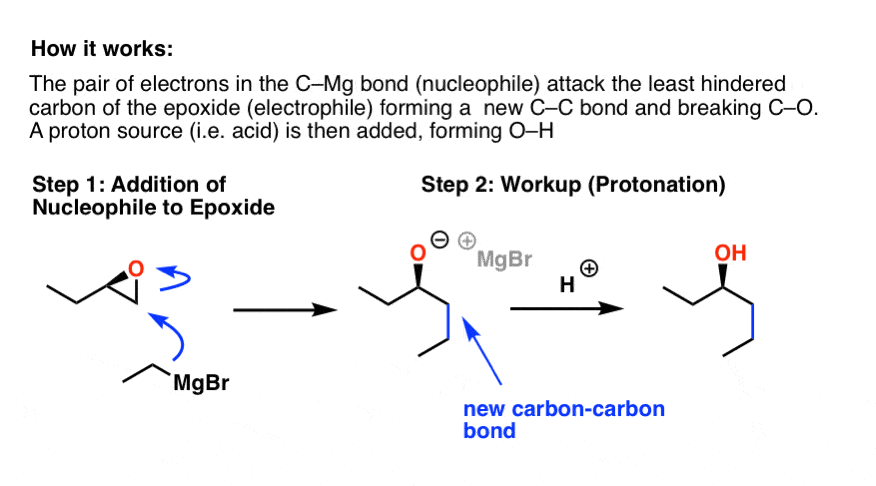
Note that this reaction also forms an “alkoxide”. In order to obtain our neutral alcohol product at the end, we must perform second step: a “workup” (“quench”) with a source of acid. This is written a variety of ways – H+, H3O+, H2O, or just “acid workup”. This step occurs after our key Grignard reaction, for what should be obvious reasons – being strong bases, Grignard reagents are destroyed by acid.
Another thing to keep in mind is stereochemistry of the epoxide.Consistent with an SN2 reaction, if the reaction occurs at a secondary carbon, we will observe inversion of configuration:
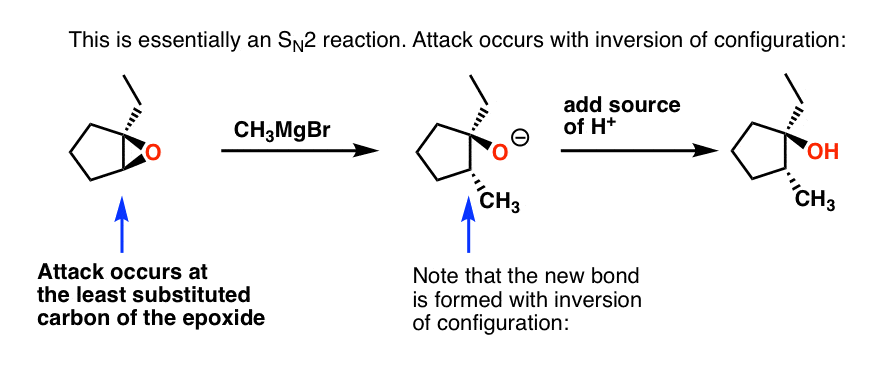
3. Reaction of Grignards With Aldehydes and Ketones
A second class of important electrophiles that react with Grignards (and arguably THE most important class of electrophiles) is aldehydes and ketones. If you haven’t covered the reactions of these functional groups yet, a short summary would be this: the carbonyl carbon is an electrophile, and when nucleophiles react at this carbon, it’s accompanied by cleavage of the C-O pi bond (π bond). (For more on the addition mechanism to carbonyls, see post: Nucleophilic Addition)
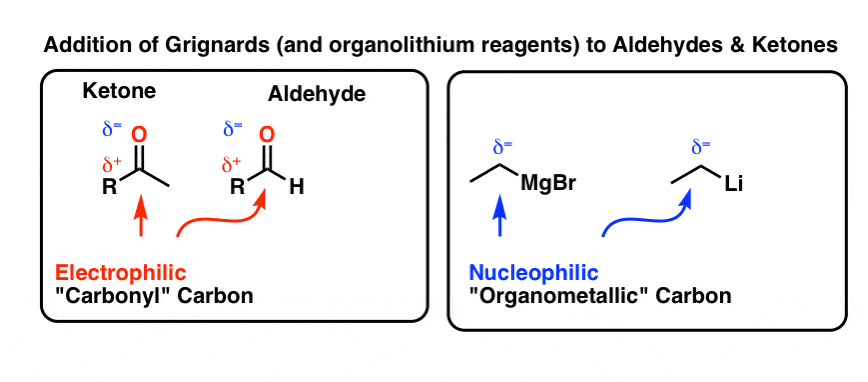
Here are some examples of reactions of Grignards with aldehydes and ketones. Note that in each case we are forming a new bond between the carbonyl carbon (labelled A) and the carbon bound to magnesium (labelled B), and we are breaking the C-O pi bond in the process.
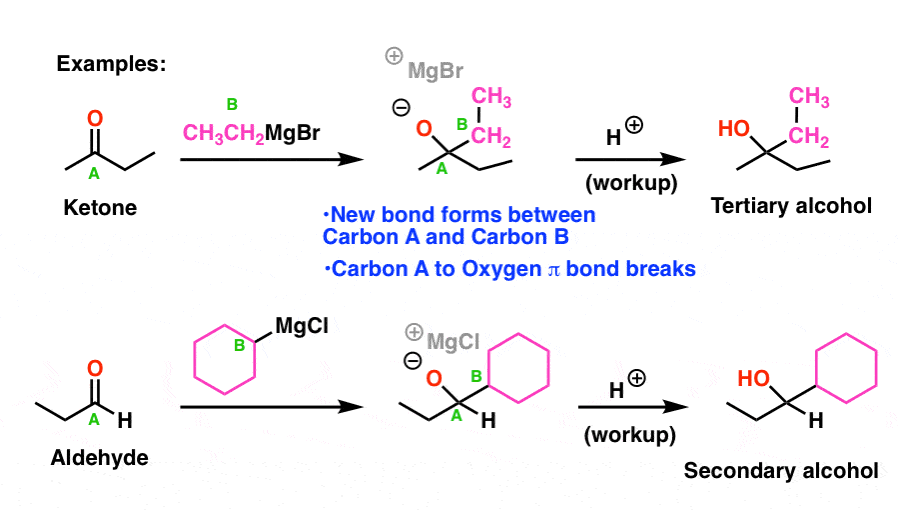
So how does this reaction work?
Let’s get familiar with a VERY important mechanism called “addition” (sometimes called, “1,2-addition”). This is by far the most important reaction of the carbonyl group, and if you give yourself a chicken for every time you will see variations of it in Org 2, you will have a lot of eggs in your room by the end of the semester.
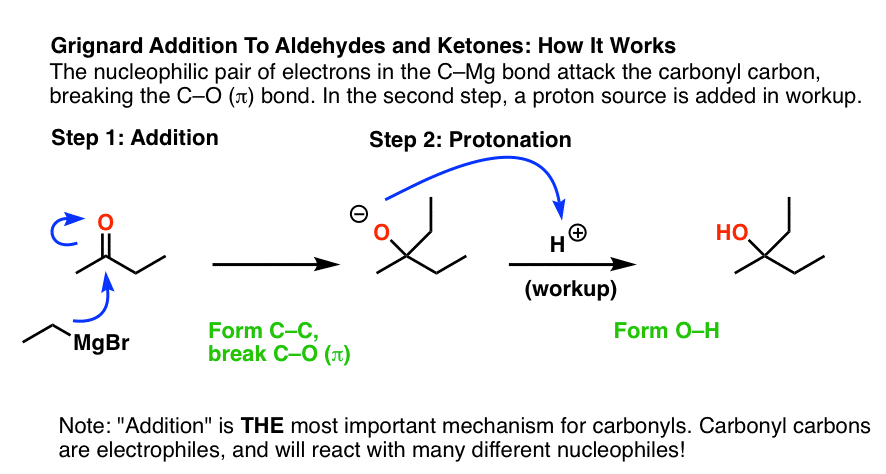
Note that this reaction also forms an “alkoxide”. In order to obtain our neutral alcohol product at the end, we must perform a “workup” (“quench”) with a source of acid, forming O-H.
4. Reaction of Grignard Reagents With Esters
Esters are close relatives of aldehydes and ketones: they consist of a carbonyl group directly attached to an OR group. As you might expect, they react with Grignards in a similar fashion to aldehydes and ketones: with formation of a new C-C bond and breakage of a C-O (pi bond).
However, there’s a twist with the reaction of esters that isn’t present with aldehydes and ketones. Look carefully: what’s different?
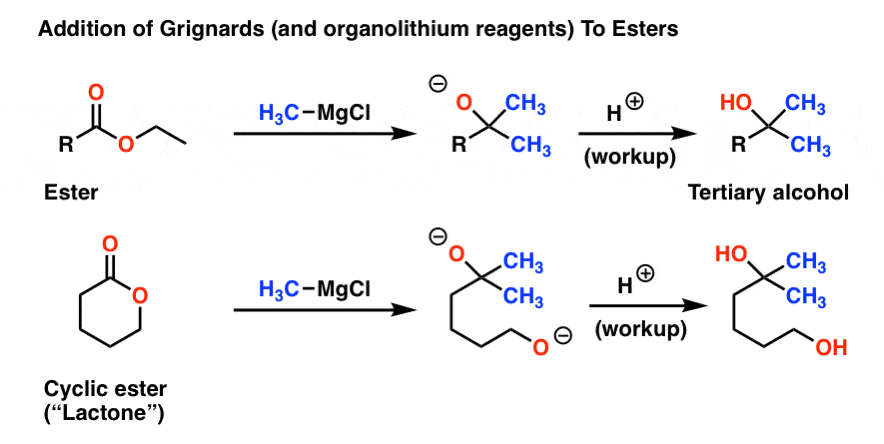
Note that in both cases we added two equivalents of our Grignard reagent to the ester, forming a tertiary alcohol.
Wait a minute – how did this happen?!
5. Why Is There “Double Addition”With Esters? The Mechanism
This reaction incorporates the second most important mechanism of carbonyls (next to “addition”), namely, “elimination“. In fact “elimination” is the exact reverse of “addition” ! Let’s walk through it. There are 4 steps
- In the first step, the Grignard performs an addition reaction on the ester, forming C-C and breaking C-O (pi), giving us an intermediate with a negatively charged oxygen. We’ve seen this type of reaction before in the addition of Grignards to aldehydes and ketones.
- Now comes the new step: elimination (sometimes, “1,2 elimination”). This intermediate has a reasonably good leaving group (OCH2CH3 in the case below). What happens next is reformation of the C-O pi bond with expulsion of the leaving group (CH3CH2O– in the case below). In other words, we form C–O π and break a C–O single bond. The new product is a ketone.
Together, these two steps are often referred to as Nucleophilic Acyl Substitution (See post: Nucleophilic Acyl Substitution)
Elimination does not occur in addition to aldehydes and ketones because the leaving group would have to be the extremely strong bases H(-) or R(-). It is reasonably favorable for esters because the leaving group RO(-) is of comparable basicity to the negatively charged oxygen of the tetrahedral intermediate. [Note 1]
- But wait! There’s more! After Step 2, we have a new ketone. As we’ve seen before, Grignards will react quickly with ketones in yet another addition reaction [Step 3]. Here, as in Step 1, we form C–C and break C–O (pi). The result is a tertiary alkoxide (the conjugate base of a tertiary alcohol).
[Wait, you might ask. If we just use one equivalent of Grignard reagent, is it possible to get the reaction to stop at the ketone stage? The short answer is “no”. [See Note 3 for the long answer]]
- Finally, protonation of this tertiary alkoxide yields the tertiary alcohol (Step 4).
Here’s the graphical walkthrough:
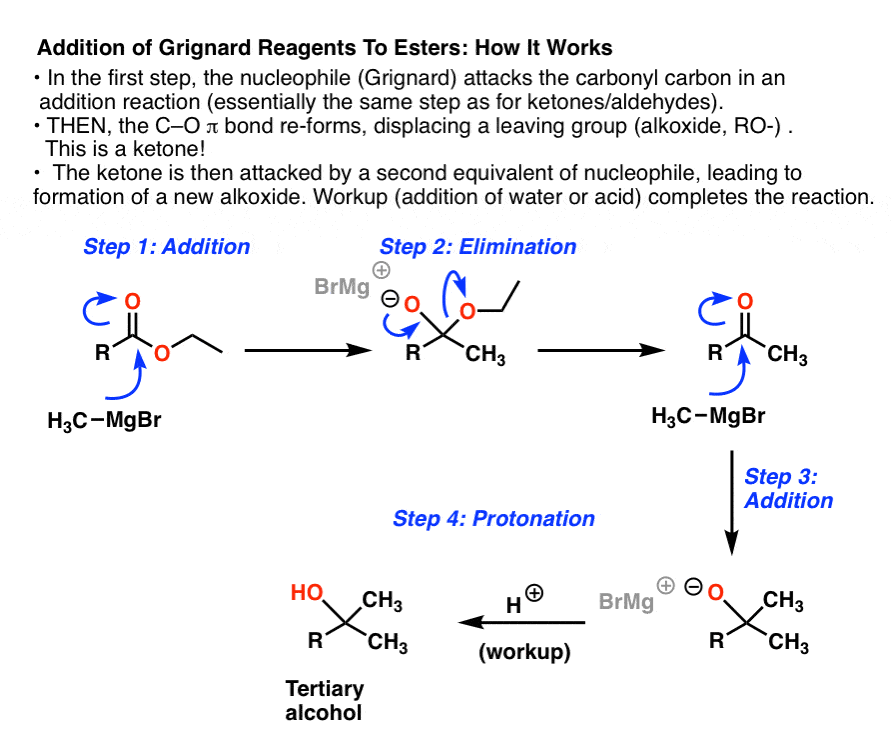
6. Summary: Reactions of Grignard Reagents
That does it for the key reactions of Grignard reagents you’ll see in most Org 1 and Org 2 courses.
In the next post we’ll talk about yet another way to screw up formation of Grignard reagents, and it involves the reactions in this post.
Next Post: Protecting Groups In Grignard Reactions
Notes
Related Articles
- Nucleophilic Addition To Carbonyls
- Nucleophilic Acyl Substitution (With Negatively Charged Nucleophiles)
- Protecting Groups In Grignard Reactions
- Grignard Practice Problems: Synthesis (1)
- Grignard Reactions And Synthesis (2)
- Gilman Reagents (Organocuprates): What They’re Used For
- Reaction Map: Reactions of Organometallics
Note 1: Although alkoxides (RO–, the conjugate base of alcohols, pKa 16-18) are not on anyone’s list of Great Leaving Groups, they are some 25 orders of magnitude better leaving groups than hydrides (H–, the conjugate base of hydrogen, pKa 40) and more than 30 orders of magnitude better than alkyl groups (R- , the conjugate base of alkanes, pKa 50). Thus, when the alkoxide intermediate is formed in Step 1, there is not any deep energetic penalty for the C-O pi bond to reform and for RO- to be expelled: after all, we are simply replacing a strong base (the O- ) with one of comparable basicity.
Note 2. Why are ketones more reactive towards Grignard reagents than esters? This requires understanding the phenomenon of pi donation. The lone pair on oxygen donates electron density into the carbonyl carbon. This is worthy of a separate post, but here’s the bottom line:
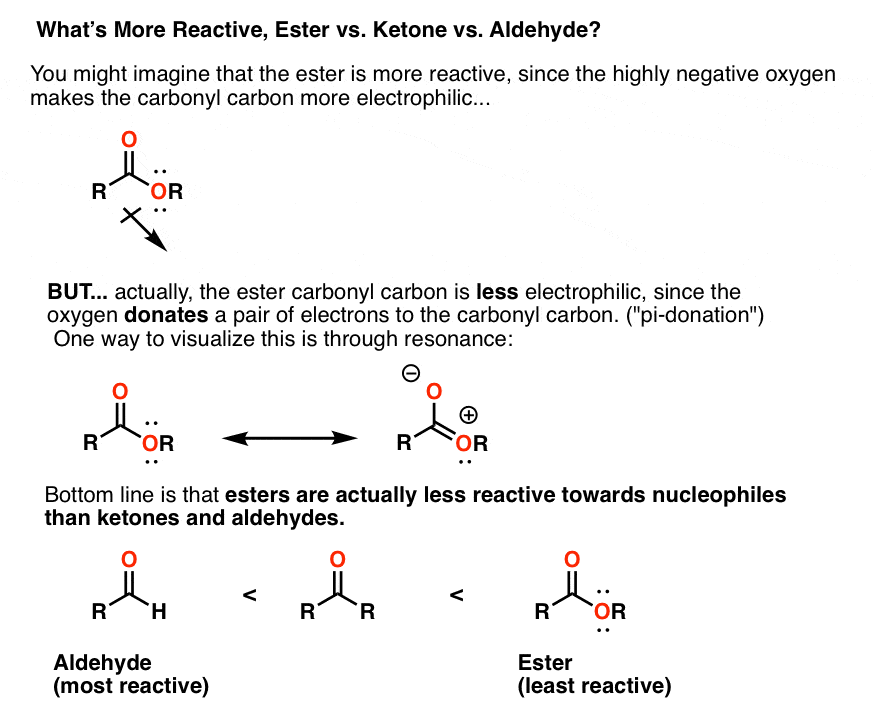
Note 3. Alas, no. Using 1 equivalent of Grignard will result in 0.5 equivalents of a tertiary alcohol and 0.5 equivalents of the starting ester. The reason why is that Step 2 [elimination] is quite fast!
Once elimination occurs, we will have ketone in the presence of an ester. For interesting reasons [see Note 2] ketones are more reactive than esters toward Grignard reagents, which means they will be consumed more quickly.
Quiz Yourself!
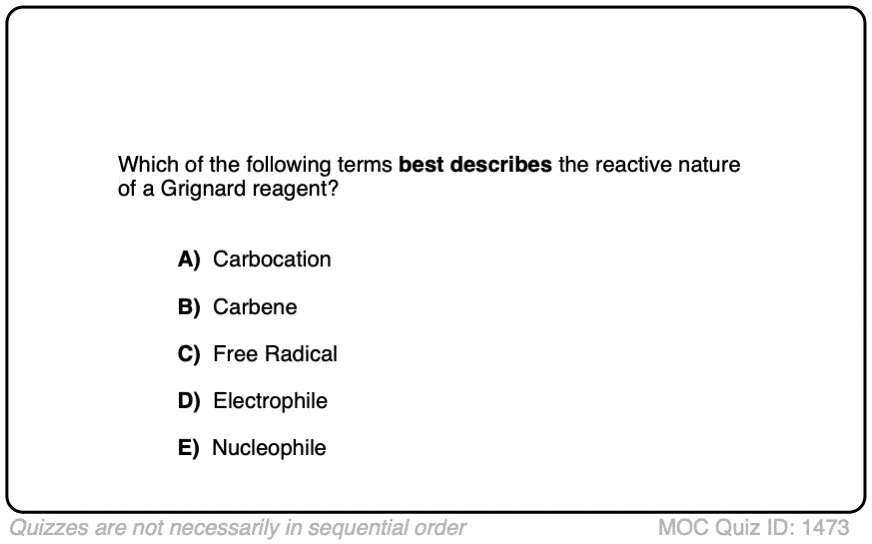 Click to Flip
Click to Flip
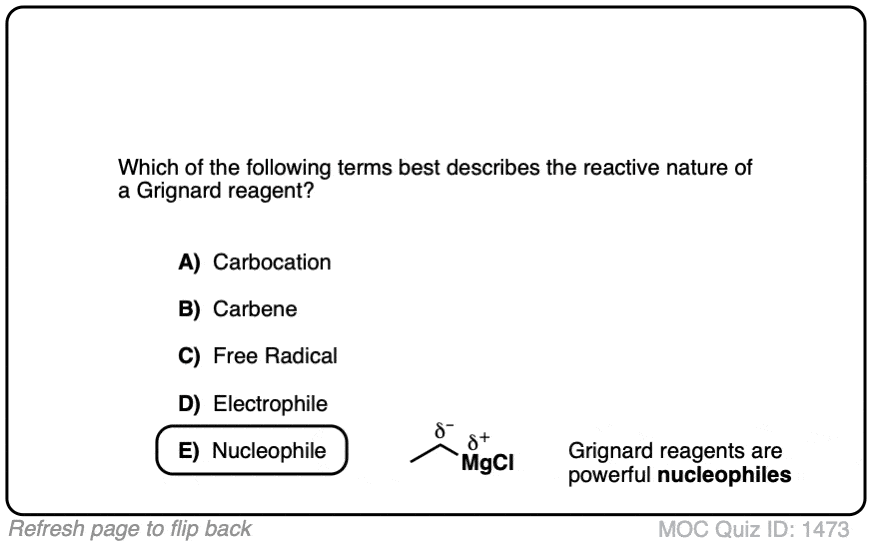
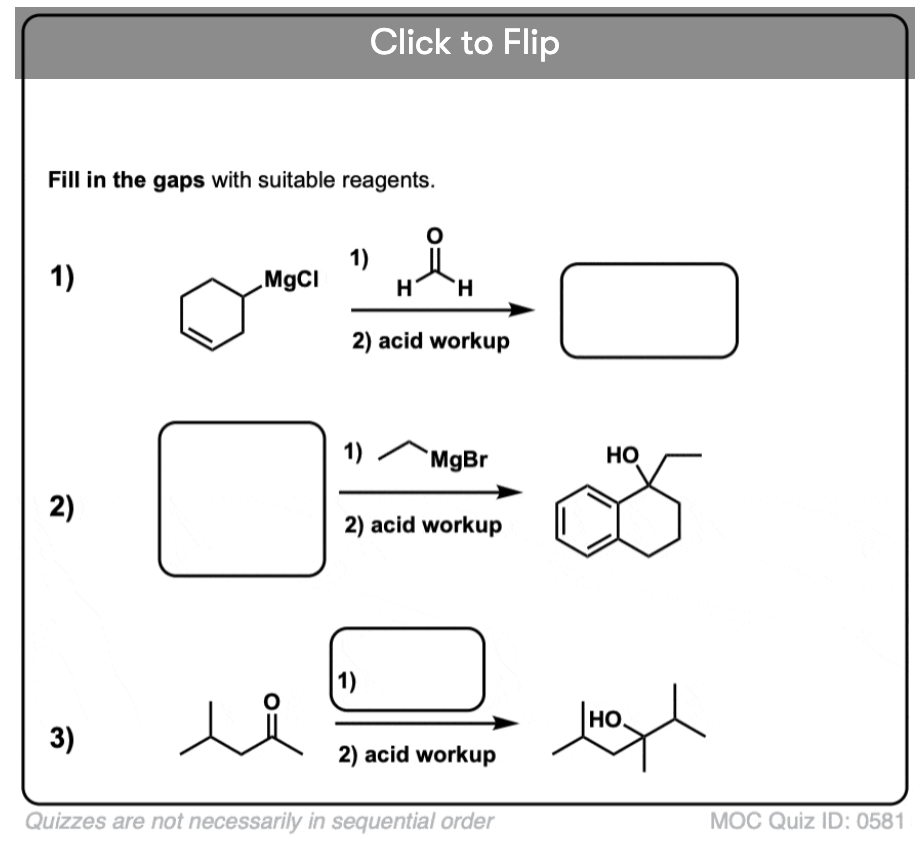
Become a MOC member to see the clickable quiz with answers on the back.
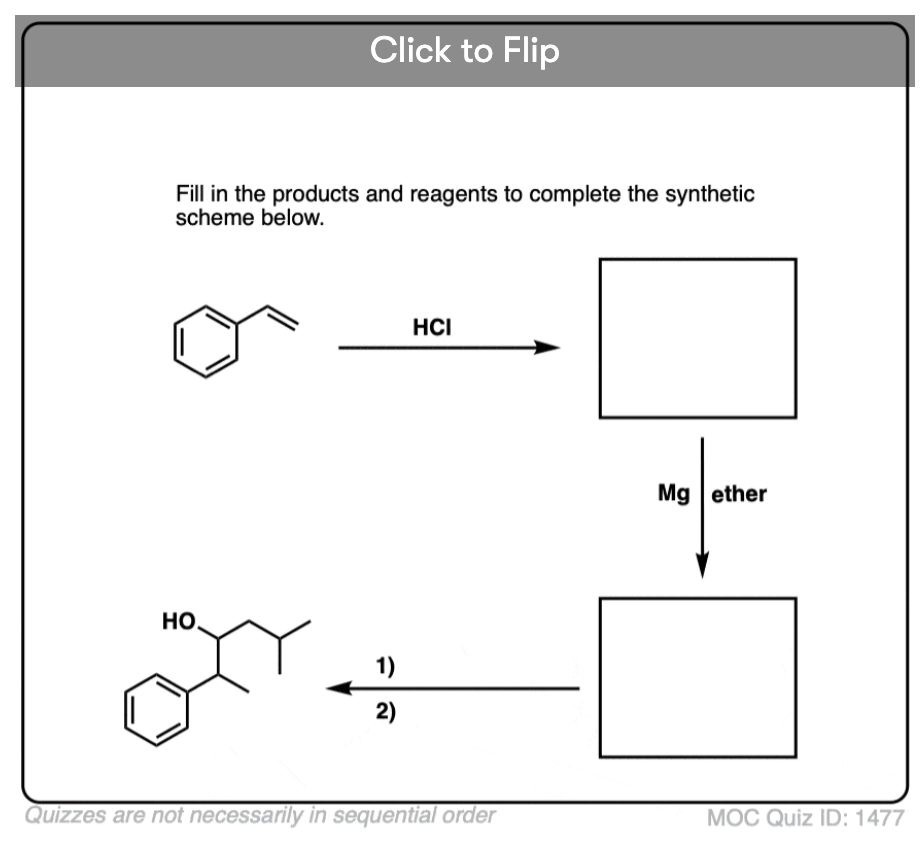
Become a MOC member to see the clickable quiz with answers on the back.
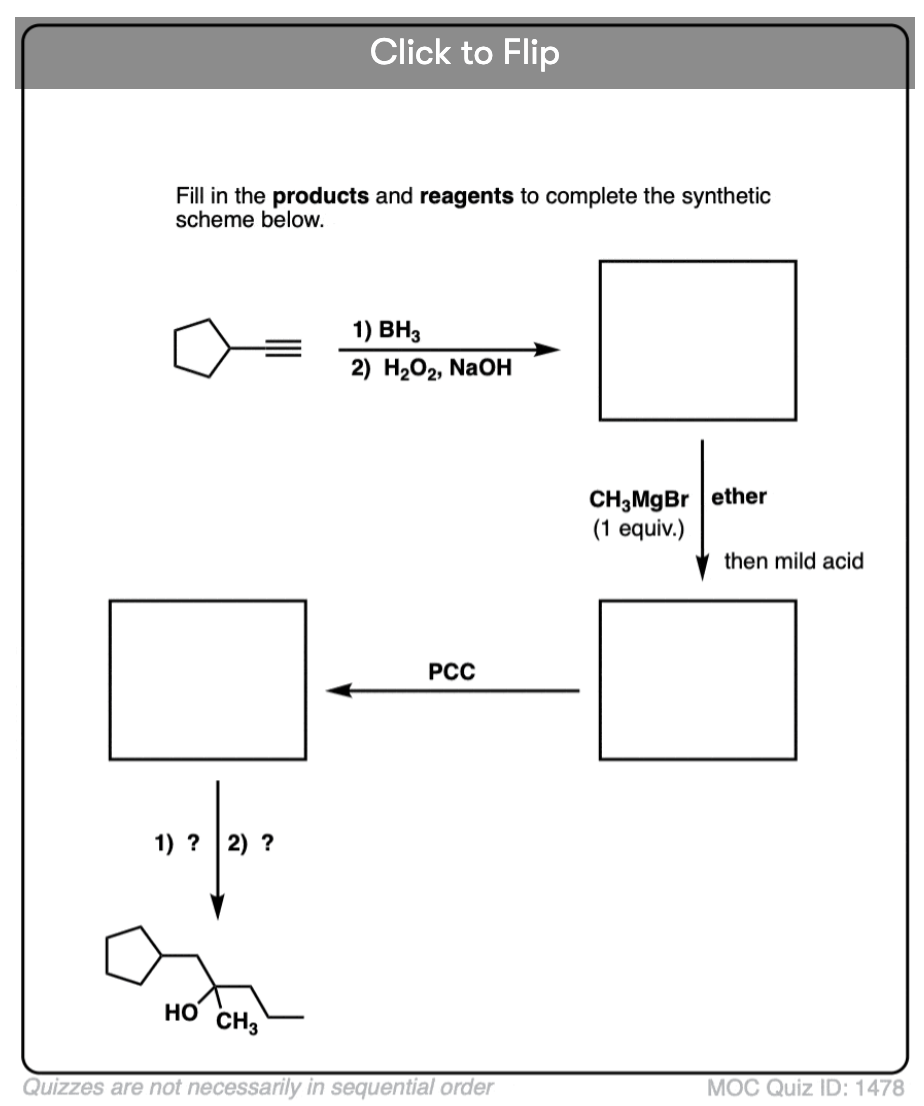
Become a MOC member to see the clickable quiz with answers on the back.
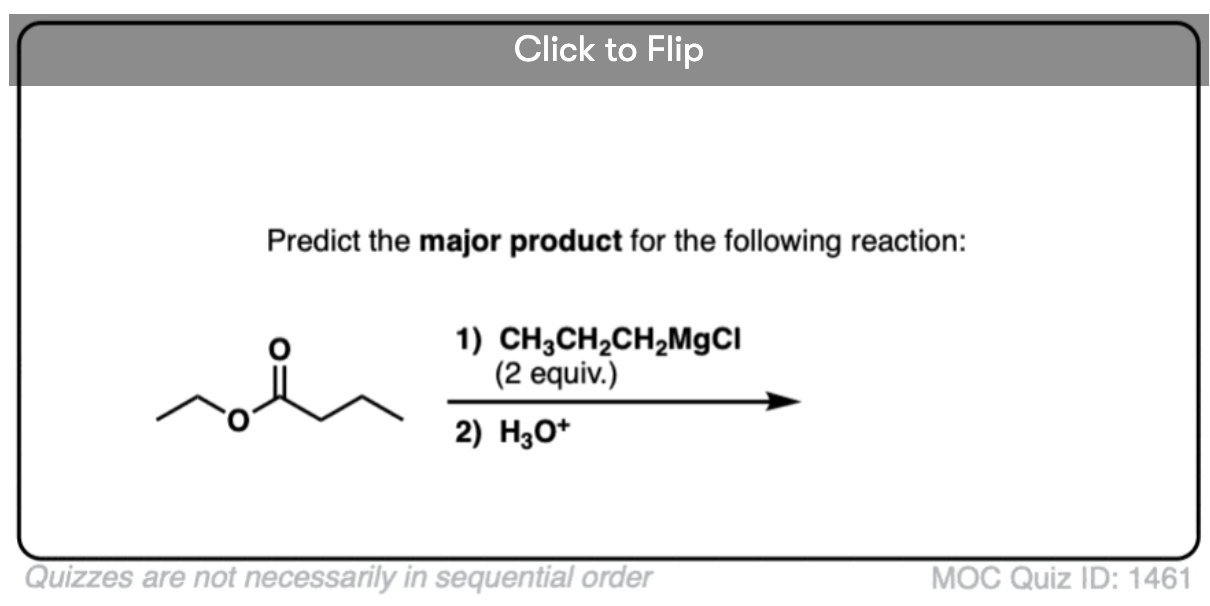
Become a MOC member to see the clickable quiz with answers on the back.
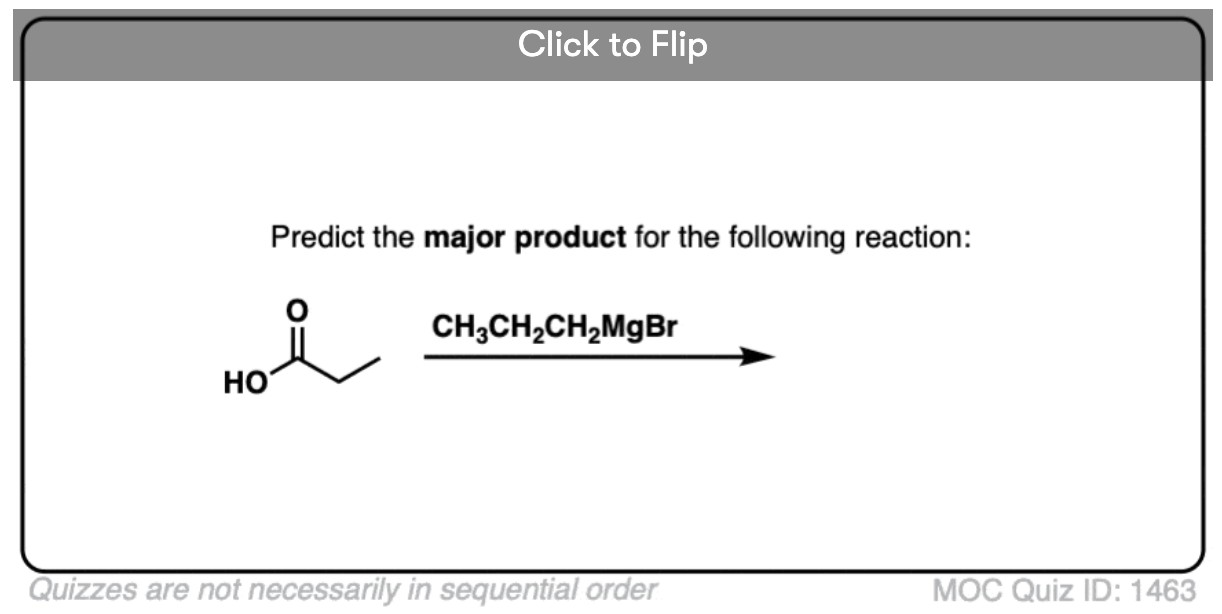
Become a MOC member to see the clickable quiz with answers on the back.
(Advanced) References and Further Reading:
- The Grignard Reagents
Dietmar Seyferth
Organometallics 2009 28 (6), 1598-1605
DOI: 10.1021/om900088z
A historical overview on Grignard reagents by the late Prof. Dietmar Seyferth (MIT), founding editor of the journal Organometallics. - Secondary and Tertiary Alkyllithium Compounds and Some Interconversion Reactions with Them
Henry Gilman, Fred W. Moore, and Ogden Baine
Journal of the American Chemical Society 1941, 63 (9), 2479-2482
DOI: 1021/ja01854a046
Prof. Henry Gilman (Iowa State) was a pioneer in organometallic chemistry in the first half of the 20th century. In this paper he describes the synthesis and reactivity of various alkyllithiums (n-butyllithium, s-butyllithium, isopropyllithium, and t-butyllithium). The synthesis is from the alkyl halide and lithium metal, as can be seen in the experimental section. - t-Butyllithium
Paul D. Bartlett, C. Gardner Swain, and Robert B. Woodward
Journal of the American Chemical Society 1941, 63 (11), 3229-3230
DOI: 1021/ja01856a501
This communication is from some legendary figures in organic chemistry and describes the preparation of t-butyllithium. - 2-PHENYLPYRIDINE
C. W. Evans and C. F. H. Allen
Org. Synth. 1938, 18, 70
DOI: 10.15227/orgsyn.018.0070
The first step in this procedure is a preparation of phenyllithium from bromobenzene and lithium metal. Organic Syntheses is a reputable source of reproducible and independently tested synthetic organic procedures. - The mechanism of the lithium – halogen Interchange reaction : a review of the literature
Bailey, W. F.; Patricia, J. J.
Organomet. Chem. 1988, 352 (1-2), 1-46
DOI: 10.1016/0022-328X(88)83017-1
In modern organic chemistry, organolithium reagents are rarely prepared from scratch (i.e. using Li metal), due to the ready availability of alkyllithium reagents from vendors (e.g. MeLi, the BuLi reagents, PhLi, etc.). Instead, these reagents can be used to form other organolithium species through a process known as lithium-halogen exchange. - What’s Going on with These Lithium Reagents?
Hans J. Reich
The Journal of Organic Chemistry 2012, 77 (13), 5471-5491
DOI: 1021/jo3005155
Prof. Hans Reich (U. Wisconsin-Madison) has spent his career studying the behavior of organolithium species, and this is an account of his research and the surprising findings he made. This is classic Physical Organic chemistry.
00 General Chemistry Review
01 Bonding, Structure, and Resonance
- How Do We Know Methane (CH4) Is Tetrahedral?
- Hybrid Orbitals and Hybridization
- How To Determine Hybridization: A Shortcut
- Orbital Hybridization And Bond Strengths
- Sigma bonds come in six varieties: Pi bonds come in one
- Dipole Moments and Dipoles
- A Key Skill: How to Calculate Formal Charge
- The Four Intermolecular Forces and How They Affect Boiling Points
- 3 Trends That Affect Boiling Points
- How To Use Electronegativity To Determine Electron Density (and why NOT to trust formal charge)
- Introduction to Resonance
- How To Use Curved Arrows To Interchange Resonance Forms
- Evaluating Resonance Forms (1) - The Rule of Least Charges
- How To Find The Best Resonance Structure By Applying Electronegativity
- Evaluating Resonance Structures With Negative Charges
- Evaluating Resonance Structures With Positive Charge
- Exploring Resonance: Pi-Donation
- Exploring Resonance: Pi-acceptors
- In Summary: Evaluating Resonance Structures
- Drawing Resonance Structures: 3 Common Mistakes To Avoid
- How to apply electronegativity and resonance to understand reactivity
- Bond Hybridization Practice
- Structure and Bonding Practice Quizzes
- Resonance Structures Practice
02 Acid Base Reactions
- Introduction to Acid-Base Reactions
- Acid Base Reactions In Organic Chemistry
- The Stronger The Acid, The Weaker The Conjugate Base
- Walkthrough of Acid-Base Reactions (3) - Acidity Trends
- Five Key Factors That Influence Acidity
- Acid-Base Reactions: Introducing Ka and pKa
- How to Use a pKa Table
- The pKa Table Is Your Friend
- A Handy Rule of Thumb for Acid-Base Reactions
- Acid Base Reactions Are Fast
- pKa Values Span 60 Orders Of Magnitude
- How Protonation and Deprotonation Affect Reactivity
- Acid Base Practice Problems
03 Alkanes and Nomenclature
- Meet the (Most Important) Functional Groups
- Condensed Formulas: Deciphering What the Brackets Mean
- Hidden Hydrogens, Hidden Lone Pairs, Hidden Counterions
- Don't Be Futyl, Learn The Butyls
- Primary, Secondary, Tertiary, Quaternary In Organic Chemistry
- Branching, and Its Affect On Melting and Boiling Points
- The Many, Many Ways of Drawing Butane
- Wedge And Dash Convention For Tetrahedral Carbon
- Common Mistakes in Organic Chemistry: Pentavalent Carbon
- Table of Functional Group Priorities for Nomenclature
- Summary Sheet - Alkane Nomenclature
- Organic Chemistry IUPAC Nomenclature Demystified With A Simple Puzzle Piece Approach
- Boiling Point Quizzes
- Organic Chemistry Nomenclature Quizzes
04 Conformations and Cycloalkanes
- Staggered vs Eclipsed Conformations of Ethane
- Conformational Isomers of Propane
- Newman Projection of Butane (and Gauche Conformation)
- Introduction to Cycloalkanes
- Geometric Isomers In Small Rings: Cis And Trans Cycloalkanes
- Calculation of Ring Strain In Cycloalkanes
- Cycloalkanes - Ring Strain In Cyclopropane And Cyclobutane
- Cyclohexane Conformations
- Cyclohexane Chair Conformation: An Aerial Tour
- How To Draw The Cyclohexane Chair Conformation
- The Cyclohexane Chair Flip
- The Cyclohexane Chair Flip - Energy Diagram
- Substituted Cyclohexanes - Axial vs Equatorial
- Ranking The Bulkiness Of Substituents On Cyclohexanes: "A-Values"
- Cyclohexane Chair Conformation Stability: Which One Is Lower Energy?
- Fused Rings - Cis-Decalin and Trans-Decalin
- Naming Bicyclic Compounds - Fused, Bridged, and Spiro
- Bredt's Rule (And Summary of Cycloalkanes)
- Newman Projection Practice
- Cycloalkanes Practice Problems
05 A Primer On Organic Reactions
- The Most Important Question To Ask When Learning a New Reaction
- Curved Arrows (for reactions)
- Nucleophiles and Electrophiles
- The Three Classes of Nucleophiles
- Nucleophilicity vs. Basicity
- What Makes A Good Nucleophile?
- What Makes A Good Leaving Group?
- 3 Factors That Stabilize Carbocations
- Equilibrium and Energy Relationships
- 7 Factors that stabilize negative charge in organic chemistry
- 7 Factors That Stabilize Positive Charge in Organic Chemistry
- What's a Transition State?
- Hammond's Postulate
- Learning Organic Chemistry Reactions: A Checklist (PDF)
06 Free Radical Reactions
- Free Radical Reactions
- 3 Factors That Stabilize Free Radicals
- Bond Strengths And Radical Stability
- Free Radical Initiation: Why Is "Light" Or "Heat" Required?
- Initiation, Propagation, Termination
- Monochlorination Products Of Propane, Pentane, And Other Alkanes
- Selectivity In Free Radical Reactions
- Selectivity in Free Radical Reactions: Bromination vs. Chlorination
- Halogenation At Tiffany's
- Allylic Bromination
- Bonus Topic: Allylic Rearrangements
- In Summary: Free Radicals
- Synthesis (2) - Reactions of Alkanes
- Free Radicals Practice Quizzes
07 Stereochemistry and Chirality
- Types of Isomers: Constitutional Isomers, Stereoisomers, Enantiomers, and Diastereomers
- How To Draw The Enantiomer Of A Chiral Molecule
- How To Draw A Bond Rotation
- Introduction to Assigning (R) and (S): The Cahn-Ingold-Prelog Rules
- Assigning Cahn-Ingold-Prelog (CIP) Priorities (2) - The Method of Dots
- Enantiomers vs Diastereomers vs The Same? Two Methods For Solving Problems
- Assigning R/S To Newman Projections (And Converting Newman To Line Diagrams)
- How To Determine R and S Configurations On A Fischer Projection
- The Meso Trap
- Optical Rotation, Optical Activity, and Specific Rotation
- Optical Purity and Enantiomeric Excess
- What's a Racemic Mixture?
- Chiral Allenes And Chiral Axes
- Stereochemistry Practice Problems and Quizzes
08 Substitution Reactions
- Nucleophilic Substitution Reactions - Introduction
- Two Types of Nucleophilic Substitution Reactions
- The SN2 Mechanism
- Why the SN2 Reaction Is Powerful
- The SN1 Mechanism
- The Conjugate Acid Is A Better Leaving Group
- Comparing the SN1 and SN2 Reactions
- Polar Protic? Polar Aprotic? Nonpolar? All About Solvents
- Steric Hindrance is Like a Fat Goalie
- Common Blind Spot: Intramolecular Reactions
- Substitution Practice - SN1
- Substitution Practice - SN2
09 Elimination Reactions
- Elimination Reactions (1): Introduction And The Key Pattern
- Elimination Reactions (2): The Zaitsev Rule
- Elimination Reactions Are Favored By Heat
- Two Elimination Reaction Patterns
- The E1 Reaction
- The E2 Mechanism
- E1 vs E2: Comparing the E1 and E2 Reactions
- Antiperiplanar Relationships: The E2 Reaction and Cyclohexane Rings
- Bulky Bases in Elimination Reactions
- Comparing the E1 vs SN1 Reactions
- Elimination (E1) Reactions With Rearrangements
- E1cB - Elimination (Unimolecular) Conjugate Base
- Elimination (E1) Practice Problems And Solutions
- Elimination (E2) Practice Problems and Solutions
10 Rearrangements
11 SN1/SN2/E1/E2 Decision
- Identifying Where Substitution and Elimination Reactions Happen
- Deciding SN1/SN2/E1/E2 (1) - The Substrate
- Deciding SN1/SN2/E1/E2 (2) - The Nucleophile/Base
- SN1 vs E1 and SN2 vs E2 : The Temperature
- Deciding SN1/SN2/E1/E2 - The Solvent
- Wrapup: The Key Factors For Determining SN1/SN2/E1/E2
- Alkyl Halide Reaction Map And Summary
- SN1 SN2 E1 E2 Practice Problems
12 Alkene Reactions
- E and Z Notation For Alkenes (+ Cis/Trans)
- Alkene Stability
- Alkene Addition Reactions: "Regioselectivity" and "Stereoselectivity" (Syn/Anti)
- Stereoselective and Stereospecific Reactions
- Hydrohalogenation of Alkenes and Markovnikov's Rule
- Hydration of Alkenes With Aqueous Acid
- Rearrangements in Alkene Addition Reactions
- Halogenation of Alkenes and Halohydrin Formation
- Oxymercuration Demercuration of Alkenes
- Hydroboration Oxidation of Alkenes
- m-CPBA (meta-chloroperoxybenzoic acid)
- OsO4 (Osmium Tetroxide) for Dihydroxylation of Alkenes
- Palladium on Carbon (Pd/C) for Catalytic Hydrogenation of Alkenes
- Cyclopropanation of Alkenes
- A Fourth Alkene Addition Pattern - Free Radical Addition
- Alkene Reactions: Ozonolysis
- Oxidative Cleavage of Vicinal Diols With NaIO4 and Pb(OAc)4
- Summary: Three Key Families Of Alkene Reaction Mechanisms
- Synthesis (4) - Alkene Reaction Map, Including Alkyl Halide Reactions
- Alkene Reactions Practice Problems
13 Alkyne Reactions
- Acetylides from Alkynes, And Substitution Reactions of Acetylides
- Partial Reduction of Alkynes With Lindlar's Catalyst
- Partial Reduction of Alkynes With Na/NH3 To Obtain Trans Alkenes
- Alkyne Hydroboration With "R2BH"
- Hydration and Oxymercuration of Alkynes
- Hydrohalogenation of Alkynes
- Alkyne Halogenation: Bromination and Chlorination of Alkynes
- Oxidation of Alkynes With O3 and KMnO4
- Alkenes To Alkynes Via Halogenation And Elimination Reactions
- Alkynes Are A Blank Canvas
- Synthesis (5) - Reactions of Alkynes
- Alkyne Reactions Practice Problems With Answers
14 Alcohols, Epoxides and Ethers
- Alcohols - Nomenclature and Properties
- Alcohols Can Act As Acids Or Bases (And Why It Matters)
- Alcohols - Acidity and Basicity
- The Williamson Ether Synthesis
- Ethers From Alkenes, Tertiary Alkyl Halides and Alkoxymercuration
- Alcohols To Ethers via Acid Catalysis
- Cleavage Of Ethers With Acid
- Epoxides - The Outlier Of The Ether Family
- Opening of Epoxides With Acid
- Epoxide Ring Opening With Base
- Making Alkyl Halides From Alcohols
- Tosylates And Mesylates
- PBr3 and SOCl2
- Elimination Reactions of Alcohols
- Elimination of Alcohols To Alkenes With POCl3
- Alcohol Oxidation: "Strong" and "Weak" Oxidants
- Demystifying The Mechanisms of Alcohol Oxidations
- Protecting Groups For Alcohols
- Thiols And Thioethers
- Calculating the oxidation state of a carbon
- Oxidation and Reduction in Organic Chemistry
- Oxidation Ladders
- SOCl2 Mechanism For Alcohols To Alkyl Halides: SN2 versus SNi
- Alcohol Reactions Roadmap (PDF)
- Alcohol Reaction Practice Problems
- Epoxide Reaction Quizzes
- Oxidation and Reduction Practice Quizzes
15 Organometallics
- What's An Organometallic?
- Formation of Grignard and Organolithium Reagents
- Organometallics Are Strong Bases
- Reactions of Grignard Reagents
- Protecting Groups In Grignard Reactions
- Synthesis Problems Involving Grignard Reagents
- Grignard Reactions And Synthesis (2)
- Organocuprates (Gilman Reagents): How They're Made
- Gilman Reagents (Organocuprates): What They're Used For
- The Heck, Suzuki, and Olefin Metathesis Reactions (And Why They Don't Belong In Most Introductory Organic Chemistry Courses)
- Reaction Map: Reactions of Organometallics
- Grignard Practice Problems
16 Spectroscopy
- Degrees of Unsaturation (or IHD, Index of Hydrogen Deficiency)
- Conjugation And Color (+ How Bleach Works)
- Introduction To UV-Vis Spectroscopy
- UV-Vis Spectroscopy: Absorbance of Carbonyls
- UV-Vis Spectroscopy: Practice Questions
- Bond Vibrations, Infrared Spectroscopy, and the "Ball and Spring" Model
- Infrared (IR) Spectroscopy: A Quick Primer On Interpreting Spectra
- IR Spectroscopy: 4 Practice Problems
- 1H NMR: How Many Signals?
- Homotopic, Enantiotopic, Diastereotopic
- Diastereotopic Protons in 1H NMR Spectroscopy: Examples
- 13-C NMR - How Many Signals
- Liquid Gold: Pheromones In Doe Urine
- Natural Product Isolation (1) - Extraction
- Natural Product Isolation (2) - Purification Techniques, An Overview
- Structure Determination Case Study: Deer Tarsal Gland Pheromone
17 Dienes and MO Theory
- What To Expect In Organic Chemistry 2
- Are these molecules conjugated?
- Conjugation And Resonance In Organic Chemistry
- Bonding And Antibonding Pi Orbitals
- Molecular Orbitals of The Allyl Cation, Allyl Radical, and Allyl Anion
- Pi Molecular Orbitals of Butadiene
- Reactions of Dienes: 1,2 and 1,4 Addition
- Thermodynamic and Kinetic Products
- More On 1,2 and 1,4 Additions To Dienes
- s-cis and s-trans
- The Diels-Alder Reaction
- Cyclic Dienes and Dienophiles in the Diels-Alder Reaction
- Stereochemistry of the Diels-Alder Reaction
- Exo vs Endo Products In The Diels Alder: How To Tell Them Apart
- HOMO and LUMO In the Diels Alder Reaction
- Why Are Endo vs Exo Products Favored in the Diels-Alder Reaction?
- Diels-Alder Reaction: Kinetic and Thermodynamic Control
- The Retro Diels-Alder Reaction
- The Intramolecular Diels Alder Reaction
- Regiochemistry In The Diels-Alder Reaction
- The Cope and Claisen Rearrangements
- Electrocyclic Reactions
- Electrocyclic Ring Opening And Closure (2) - Six (or Eight) Pi Electrons
- Diels Alder Practice Problems
- Molecular Orbital Theory Practice
18 Aromaticity
- Introduction To Aromaticity
- Rules For Aromaticity
- Huckel's Rule: What Does 4n+2 Mean?
- Aromatic, Non-Aromatic, or Antiaromatic? Some Practice Problems
- Antiaromatic Compounds and Antiaromaticity
- The Pi Molecular Orbitals of Benzene
- The Pi Molecular Orbitals of Cyclobutadiene
- Frost Circles
- Aromaticity Practice Quizzes
19 Reactions of Aromatic Molecules
- Electrophilic Aromatic Substitution: Introduction
- Activating and Deactivating Groups In Electrophilic Aromatic Substitution
- Electrophilic Aromatic Substitution - The Mechanism
- Ortho-, Para- and Meta- Directors in Electrophilic Aromatic Substitution
- Understanding Ortho, Para, and Meta Directors
- Why are halogens ortho- para- directors?
- Disubstituted Benzenes: The Strongest Electron-Donor "Wins"
- Electrophilic Aromatic Substitutions (1) - Halogenation of Benzene
- Electrophilic Aromatic Substitutions (2) - Nitration and Sulfonation
- EAS Reactions (3) - Friedel-Crafts Acylation and Friedel-Crafts Alkylation
- Intramolecular Friedel-Crafts Reactions
- Nucleophilic Aromatic Substitution (NAS)
- Nucleophilic Aromatic Substitution (2) - The Benzyne Mechanism
- Reactions on the "Benzylic" Carbon: Bromination And Oxidation
- The Wolff-Kishner, Clemmensen, And Other Carbonyl Reductions
- More Reactions on the Aromatic Sidechain: Reduction of Nitro Groups and the Baeyer Villiger
- Aromatic Synthesis (1) - "Order Of Operations"
- Synthesis of Benzene Derivatives (2) - Polarity Reversal
- Aromatic Synthesis (3) - Sulfonyl Blocking Groups
- Birch Reduction
- Synthesis (7): Reaction Map of Benzene and Related Aromatic Compounds
- Aromatic Reactions and Synthesis Practice
- Electrophilic Aromatic Substitution Practice Problems
20 Aldehydes and Ketones
- What's The Alpha Carbon In Carbonyl Compounds?
- Nucleophilic Addition To Carbonyls
- Aldehydes and Ketones: 14 Reactions With The Same Mechanism
- Sodium Borohydride (NaBH4) Reduction of Aldehydes and Ketones
- Grignard Reagents For Addition To Aldehydes and Ketones
- Wittig Reaction
- Hydrates, Hemiacetals, and Acetals
- Imines - Properties, Formation, Reactions, and Mechanisms
- All About Enamines
- Breaking Down Carbonyl Reaction Mechanisms: Reactions of Anionic Nucleophiles (Part 2)
- Aldehydes Ketones Reaction Practice
21 Carboxylic Acid Derivatives
- Nucleophilic Acyl Substitution (With Negatively Charged Nucleophiles)
- Addition-Elimination Mechanisms With Neutral Nucleophiles (Including Acid Catalysis)
- Basic Hydrolysis of Esters - Saponification
- Transesterification
- Proton Transfer
- Fischer Esterification - Carboxylic Acid to Ester Under Acidic Conditions
- Lithium Aluminum Hydride (LiAlH4) For Reduction of Carboxylic Acid Derivatives
- LiAlH[Ot-Bu]3 For The Reduction of Acid Halides To Aldehydes
- Di-isobutyl Aluminum Hydride (DIBAL) For The Partial Reduction of Esters and Nitriles
- Amide Hydrolysis
- Thionyl Chloride (SOCl2) And Conversion of Carboxylic Acids to Acid Halides
- Diazomethane (CH2N2)
- Carbonyl Chemistry: Learn Six Mechanisms For the Price Of One
- Making Music With Mechanisms (PADPED)
- Carboxylic Acid Derivatives Practice Questions
22 Enols and Enolates
- Keto-Enol Tautomerism
- Enolates - Formation, Stability, and Simple Reactions
- Kinetic Versus Thermodynamic Enolates
- Aldol Addition and Condensation Reactions
- Reactions of Enols - Acid-Catalyzed Aldol, Halogenation, and Mannich Reactions
- Claisen Condensation and Dieckmann Condensation
- Decarboxylation
- The Malonic Ester and Acetoacetic Ester Synthesis
- The Michael Addition Reaction and Conjugate Addition
- The Robinson Annulation
- Haloform Reaction
- The Hell–Volhard–Zelinsky Reaction
- Enols and Enolates Practice Quizzes
23 Amines
- The Amide Functional Group: Properties, Synthesis, and Nomenclature
- Basicity of Amines And pKaH
- 5 Key Basicity Trends of Amines
- The Mesomeric Effect And Aromatic Amines
- Nucleophilicity of Amines
- Alkylation of Amines (Sucks!)
- Reductive Amination
- The Gabriel Synthesis
- Some Reactions of Azides
- The Hofmann Elimination
- The Hofmann and Curtius Rearrangements
- The Cope Elimination
- Protecting Groups for Amines - Carbamates
- The Strecker Synthesis of Amino Acids
- Introduction to Peptide Synthesis
- Reactions of Diazonium Salts: Sandmeyer and Related Reactions
- Amine Practice Questions
24 Carbohydrates
- D and L Notation For Sugars
- Pyranoses and Furanoses: Ring-Chain Tautomerism In Sugars
- What is Mutarotation?
- Reducing Sugars
- The Big Damn Post Of Carbohydrate-Related Chemistry Definitions
- The Haworth Projection
- Converting a Fischer Projection To A Haworth (And Vice Versa)
- Reactions of Sugars: Glycosylation and Protection
- The Ruff Degradation and Kiliani-Fischer Synthesis
- Isoelectric Points of Amino Acids (and How To Calculate Them)
- Carbohydrates Practice
- Amino Acid Quizzes
25 Fun and Miscellaneous
- A Gallery of Some Interesting Molecules From Nature
- Screw Organic Chemistry, I'm Just Going To Write About Cats
- On Cats, Part 1: Conformations and Configurations
- On Cats, Part 2: Cat Line Diagrams
- On Cats, Part 4: Enantiocats
- On Cats, Part 6: Stereocenters
- Organic Chemistry Is Shit
- The Organic Chemistry Behind "The Pill"
- Maybe they should call them, "Formal Wins" ?
- Why Do Organic Chemists Use Kilocalories?
- The Principle of Least Effort
- Organic Chemistry GIFS - Resonance Forms
- Reproducibility In Organic Chemistry
- What Holds The Nucleus Together?
- How Reactions Are Like Music
- Organic Chemistry and the New MCAT
26 Organic Chemistry Tips and Tricks
- Common Mistakes: Formal Charges Can Mislead
- Partial Charges Give Clues About Electron Flow
- Draw The Ugly Version First
- Organic Chemistry Study Tips: Learn the Trends
- The 8 Types of Arrows In Organic Chemistry, Explained
- Top 10 Skills To Master Before An Organic Chemistry 2 Final
- Common Mistakes with Carbonyls: Carboxylic Acids... Are Acids!
- Planning Organic Synthesis With "Reaction Maps"
- Alkene Addition Pattern #1: The "Carbocation Pathway"
- Alkene Addition Pattern #2: The "Three-Membered Ring" Pathway
- Alkene Addition Pattern #3: The "Concerted" Pathway
- Number Your Carbons!
- The 4 Major Classes of Reactions in Org 1
- How (and why) electrons flow
- Grossman's Rule
- Three Exam Tips
- A 3-Step Method For Thinking Through Synthesis Problems
- Putting It Together
- Putting Diels-Alder Products in Perspective
- The Ups and Downs of Cyclohexanes
- The Most Annoying Exceptions in Org 1 (Part 1)
- The Most Annoying Exceptions in Org 1 (Part 2)
- The Marriage May Be Bad, But the Divorce Still Costs Money
- 9 Nomenclature Conventions To Know
- Nucleophile attacks Electrophile
27 Case Studies of Successful O-Chem Students
- Success Stories: How Corina Got The The "Hard" Professor - And Got An A+ Anyway
- How Helena Aced Organic Chemistry
- From a "Drop" To B+ in Org 2 – How A Hard Working Student Turned It Around
- How Serge Aced Organic Chemistry
- Success Stories: How Zach Aced Organic Chemistry 1
- Success Stories: How Kari Went From C– to B+
- How Esther Bounced Back From a "C" To Get A's In Organic Chemistry 1 And 2
- How Tyrell Got The Highest Grade In Her Organic Chemistry Course
- This Is Why Students Use Flashcards
- Success Stories: How Stu Aced Organic Chemistry
- How John Pulled Up His Organic Chemistry Exam Grades
- Success Stories: How Nathan Aced Organic Chemistry (Without It Taking Over His Life)
- How Chris Aced Org 1 and Org 2
- Interview: How Jay Got an A+ In Organic Chemistry
- How to Do Well in Organic Chemistry: One Student's Advice
- "America's Top TA" Shares His Secrets For Teaching O-Chem
- "Organic Chemistry Is Like..." - A Few Metaphors
- How To Do Well In Organic Chemistry: Advice From A Tutor
- Guest post: "I went from being afraid of tests to actually looking forward to them".
Why don’t grignard reagents do SN2 with alkyl halides?
I don’t have a great or satisfying answer for you. They just tend not to, or in cases where they do, the yields are low and are accompanied by other products.
The best substrates for SN2 reactions are alkyl halides, and generally what tends to happen is either no reaction, or the Grignard reagent reduces the alkyl halide to an alkane. Deprotonation can also happen.
Part of the reason is that the structure of Grignard reagents in solution is not simple – they form clusters – and this is not good from a steric hindrance standpoint. Also, what makes Grignards add so well to the C=O group is that the magnesium can act as a Lewis acid and activate the carbonyl towards nucleophilic attack. The halogen of alkyl halides are not activated (i.e. made into a better leaving group) by magnesium.
In order to do SN2 reactions, the best choice is to use a Gilman reagent (organocuprate). Those work well, especially with primary alkyl halides. They are less basic and perform fewer side reactions.
What happens when CH3MgBr reacts with Pent-2,4-dione?
How many equivalents of CH3MgBr?
Due to keto-enol tautomerism pent-2,4-dione has an acidic enol O-H that may be deprotonated faster than addition to the carbonyl can occur.
Can a Grignard reagent interact with molecular nitrogen, as in N2 gas?
No. Molecular N2 does not interact with Grignard reagents, but there are other metallic compounds which do (molybdenum compounds come to mind).
If we were to do an acid work up right after the first step of reaction of Grignard reagent with an ester, could a hemiacetal be formed? If not, why?
No, it’s not practical to quench the reaction fast enough to get single addition in most cases. There are ways to do mono-addition to form ketones from esters (e.g. using a Weinreb amide) but a fast quench of a Grignard is not it.
Why is acidic workup not done after the first step in case of reaction with ester?
There is no good way to time the workup so that it is done after the first addition occurs but before the second does.
After the first addition happens, the subsequent breakdown to the ketone and second addition occur very quickly.
If a ketone is desired, there are species known as “Weinreb amides” that form a stable tetrahedral intermediate after the first addition. This tetrahedral intermediate can be quenched and a ketone obtained.
Why grignard reaction need extremely cold conditions like -78°C
It does not, Grignard reactions happen fine at room temperature and above.
Hi James,
Thanks for creating this website. It has helped me a lot and I can’t thank you enough.
I have one doubt. Please if you can help me out. What happens when you take a very sterically hindered carbonyl or acid derivative substrate and equally sterically hindered grignard reagent? The mechanism in both case I believe is SN2 and SN(addition-elimination). Will the reaction proceed? Or not? Or if it does then how? And do you have any reference which I can go through? Actually back in the college, one of my professors had taught us about bulky G.R. giving out hydride , which attacks further on sterically hindered substrates. But since, I am not in college now, I can’t ask that professor. And I haven’t been able to find it in any standard textbooks. I checked clayden, klein and bruice.
You’ll probably have reduction of the carbonyl. I would check out March’s Advanced Organic Chemistry.
What happens if do not wash with saturated NaCl solution at the last step of Grignard reaction
A Grignard is generally quenched with aqueous solution and extracted with organic solvent. The purpose of the extraction is to remove any magnesium salts and other polar byproducts.
Can NaCl react with CH3MgBr?
One of the issues for NaCl would be getting it to dissolve in an appropriate solvent. But let’s just say we were able to get some to dissolve in ether, in the presence of CH3MgBr. About the only thing that might happen is some of the Br ions of the Grignard reagent might exchange with some of the Cl ions from the NaCl. This would not influence the reactivity of the Grignard reagent in any significant way. I hope this answers your question.
Can Grignard Reagent react with alkenes?
Thank You!
can we say what you explained in point 5 in another way that in esters there is a 4 member chelate formation due to ion-dipole interaction between oxygen and (MgBr)+ and as 4 member ring is not comfortable so it breaks and form MgBrOR and leaving us ketone
Hi, Will other organometallics react in the similar way as grignard reagent?
No, not exactly, the choice of metal can have a very large effect on reactivity. The reagents that are the most similar to Grignard reagents are organolithium reagents, which will also add to carbonyls (aldehydes, ketones, esters) as well as act as strong bases. Note that the electronegativity of lithium is very close to magnesium. Once you get toward the right half of the periodic table (such as copper or palladium) the reactivity becomes very different; the organometallic reagents are not nearly as basic, and there is much stronger bonding to “soft” species such as alkenes.
I had a doubt…in grignard synthesis of alcohols using carbonyl groups we usually get higher order(carbon wise) in the product so does this reaction exists:
R-Mg-X—>ROH i.e we get the same order
No, in that case you’re forming a C-OH bond, not a C-C bond, so you’d need to add a source of electrophilic oxygen.
In the reaction with esters, why does the nucleophile C2H5O- not attack in the second step, only grignard reagents attack?
It could attack, but attack is reversible. In contrast, the reaction with Grignards is irreversible since carbanions are such strong bases and poor leaving groups.
Hi
Can you please tell me grignard reagent reaction with 1 degree, 2 degree and 3 degree amines
No reaction, generally.
What will be the reaction of O2 with grignard reagent?
Grignards can react with O2 to give hydroperoxides, which can then be reduced to alcohols. See https://pubs.acs.org/doi/abs/10.1021/ja01627a069
What will be th action of RMgCl/RLi towards all type of amides? &also reply how many moles of Grignard reagents can be consumed by one mole of any type of amide(P/S/T)
For primary or secondary amides – deprotonation. For tertiary amides they do not generally give addition products. One exception is Weinreb amides. https://en.wikipedia.org/wiki/Weinreb_ketone_synthesis
Why does grignard reagent break cyclic ethers using only SN2 mechanism but not any SN1 ? A small question
I ask this because, during SN2 we should have bond breaking and making simultaneously. GR instead acts as a sp2 addition nucleophile…..
Kindly reply…plz
Generally Grignard reagents do not react with ethers… e.g. diethyl ether and THF are commonly used as solvents.
i get that, but what i wanted was to know a double bonds reactivity, like if in a compound both double bond(between 2 carbons) and a aldehyde is given, what will grignard reagent react with first.
Aldehyde. Grignards will add to carbonyls (1,2) before they do conjugate addition (1,4)
what is more reactive with grignard reagent, Aldehyde vs. Ketone vs. Ester vs. Alkene
Aldehyde > Ketone > Ester.
But here’s a question for you. Why?
Etheneone is C2H2O.Aliphatic stucture with a SP2 hybridisation to the carbon which has oxygen double bond.
Ah, I never heard “ketene” called etheneone before. Should still add 1,2.
What would be the reaction of Ethenone with Grignard reagent
I’m not sure what you’re referring to as ethenone, but if you mean methyl vinyl ketone, the answer is that Grignards add to the ketone.
Why alpha Carbon needs to be perpendicular to the carbonyl for deprotonation in ketones.
So that when the C-H bond breaks, the orbital (and its resulting lone pair) is aligned with p-orbitals in the C=O pi system, allowing for resonance stabilization.
Such a great job putting all this together
Thank you Philip – glad you find it useful.
I have worked on this Grignard addition to a Weinred amide:
2-ethyl hexyl MgBr + 2-ethyl hexyl-(C=O)-N(-Me)(-OMe)
The Grignard is from Sigma aldrich and the amide is lab-made.
A brief conclusion is that this reaction did not work. I recover the amide both by TLC and by 1H NMR.
Do you think this is caused by steric hindrance?
I doubt it is a steric hindrance issue. I wonder if it is a Grignard issue. I generally have seen better results using the organolithium reagents.
what is the reason behind this?
Do Grignards react with ethers? If yes then how?
No they do not. That is why ethers are useful protecting groups.
Another question!Is first step in addition of RMgX to ketones a SN2?is it a backside attack?what about stereochem?
It’s a carbonyl addition reaction and it could happen from either face of the ketone.
Hello! what about reaction of CO2 with grignard to form carboxilic acids?any post about it?
What is the stereochemistry of the product formed in the reaction of aldehyde or ketone with grignards reagent
Without a source of chirality, any addition that forms a chiral center will result in a mixture of stereoisomers.
What about the reaction of grignard reagent with nitriles and isonitriles?
Grignard reagents will give ketones, after hydrolysis of the intermediate imine. See https://pubs.acs.org/doi/abs/10.1021/ja00796a022
Relative reactivity order of grignard reagent with respect to alkyl group
On an absolute scale, it will correlate pretty well with basicity, but that’s not taking steric factors into account. The problem with Grignards is usually not that they aren’t “reactive enough”, but that the substrate is sterically hindered and side reactions result.
What happens when grignard reagent is reacted with 2° alcohol
It will be deprotonated to give the epoxide. An acid-base reaction, in other words. That’s it.
Ok… I get what grignard reagent would do with all the above-mentioned compounds… But I am stuck on this question…
Acetyl bromide reacting with excess of CH3MgI followed by treatment with a saturated solution of NH4Cl gives???
You’ve got an an acid chloride reacting with an excess of Grignard reagent. Acid chlorides react similarly to esters. The Grignard adds twice.
In many cases the workup step says, “H+”. However this can cause confusion because H+ in the presence of a tertiary alcohol can lead to formation of a carbocation (remember sn1 with alcohols). So instead of H+, NH4+ Cl- is sometimes used in the workup step. This is a strong enough acid (pKa 10) to protonate the negatively charged oxygen, but not a strong enough acid to protonate the neutral OH and thus go down the SN1/E1 pathway.
Does that help?
Hey, what will be the product for a three degree alcohols reacting with ‘traces of GR and H+’. Thankyou!
A tertiary alcohol reacting with “traces of grignard reagent” and H+. That doesn’t make any sense to me. Grignard reagents are destroyed by H+.
That was my conclusion too. This question was in my textbook. Perhaps a misprint. Thanks for all the help :)
Reactivity order of all oxygen contain compounds towards grignard reagent(aldehyde,ketone,ester,acid chloride,carboxylic acid,acid anhydrides,acid amide)?
aldehyde and acid chloride > ketone > ester >> amide. Carboxylic acids protonate Grignards and they don’t add to carboxylates.
Is it possible to form a ‘Grignard’ reagent with other Gp2 metals? Are the larger Gp2 metal ions not sufficiently polarising due to their lower charge density? I just ran an exam revision course and found this thread very useful for an unusual A level chem topic.
Hi Robert. Organocalcium species are known, but from my understanding they tend to give a lot of Wurtz-type coupling (much like organosodium reagents). I haven’t dug into this reference but it is covered here: J. Org. Chem. 1993 58, 1187. https://pubs.acs.org/doi/10.1021/jo00057a035
What is the stereochemistry of the final product?
is it Racemic?
Hi Adam, it would depend on several factors. If you’re talking about epoxide opening, then if you start with a chiral, non-racemic epoxide, you’ll end up with a chiral, non racemic product because the stereocenter is unaffected. If you’re talking about addition to an achiral aldehyde or ketone, then in the absence of any chiral influence you’ll obtain a racemic product. If you’re talking about addition to a chiral, but racemic aldehyde or ketone then in the absence of any chiral influence you’ll end up with a mixture of diastereomers. This is a good question and deserves its own blog post.
How do you know when to use H3O+ v. NH4Cl?
That’s a great question. I put in both because you might see either. It’s very instructor dependent.
For introductory organic purposes, however, you can think of them as the same.
In practice NH4Cl is a little milder, especially with acid-sensitive molecules that might react with H3O+ . NH4Cl is a “safe choice” when you need a mild acid for workup.
Is the order of reactivity correct? Grignard reactivity order : chloride> anhydride> aldehyde> ketone> ester>amide?
Sounds about right. I wouldn’t want to try to run a competition experiment between an acid chloride and an aldehyde, but aldehydes are certainly more reactive than ketones.
Can a grignard reagent react with a molecule that does not have a functional group, such as methylcyclopropane?
Methylcyclopropane, no, because there’s no electron sink for the carbanion that would result. They can certainly react with acidic hydrocarbons like terminal alkynes and cyclopentadiene.
Hi, why can’t Grignards react with the alpha carbon on ketones and aldehydes since the pKa of that alpha carbon is around ~20 while the pKa of an alkane hydrogen is ~50?
Great question Jon. One of the tricky bits we don’t mention too much is that in order for the C-H bond to actually be acidic, it has to be aligned at 90 degrees to the carbonyl. So when the Grignard is in the vicinity of the carbonyl, two things can happen; it can add, or it can remove the C-H bond. However like I said the C-H bond has to be aligned perfectly for that to happen, whereas the carbonyl is under no such restraint.
The upshot is that addition tends to be faster than deprotonation in this case, so long as the carbonyl isn’t too sterically hindered.
Forgive me if I’m wrong, but for the illustration that appears just above the header “2. Reaction of Grignards With Aldehydes and Ketones,” did the ethyl group (going out of the plane) in the cycloheptane ring change to a methyl group by mistake?
Yes you are correct. Thanks for the spot. Fixed!
So I have a question, why does the reagent not get protonated in Ketones instead of attacking the carbonyl group?
The reagent can get protonated in cases where the Grignard or the ketone are sterically hindered. One complication of acidity of the alpha position of aldehydes or ketones is that the alpha C-H bond must be aligned with the C=O bond in order for it to be acidic; otherwise the resulting carbanion would not be resonance stabilized. There is no such barrier to addition to the carbonyl.
Grignard with amide?
Certainly not for primary or secondary amides. For intro organic chemistry puposes, generally amides considered to be unreactive…. but google “weinreb amide” for a more advanced treatment.
I was wondering about the reactivity of different grignards reagents, with the same R group. Meaning I, Cl, Br. If I where to have two methyl halogens in the solution, which one would be more readily to form the grignard?
The order of halide activity is I > Br > Cl. See March’s advanced organic chemistry 5th edition page 805. Under “Metallo-de-halogenation”.
Does presence of NH4Cl or H3O+ effect the sn2 mechanism of epoxide with GR?
NH4Cl or H3O+ will destroy Grignard reagent. Some Lewis acids (e.g. CeCl3) are compatible with Grignards however.
Esters are less reactive than ketones for addition, what about carbonyl halides?
Esters are certainly less reactive than ketones. I don’t know of a good competition experiment between a carbonyl halide and a ketone or aldehyde. All I would say is that in these three cases the first addition is very fast.
A question:If one equivalent of grignard reagent is made to reacts with a compound that contains a double bond and a carbonyl group(C=O),grignard will attack which one?
The carbonyl group. Addition to the double bond can be effected if you add a catalytic amount of a copper(I) salt such as CuBr.
reactions of grignard reagent will be affected or not by the change of solvent from protic to aprotic.
Grignard reagents will be destroyed if added to a protic solvent such as an alcohol or water.
Hey what if 1,3 dibromopropane reacts with grignard?
You will get a most interesting product with chemical formula C3H6. Can you figure out what it is?
What is the reaction between grignard reagent and ammonia?
I have never seen the use of a Grignard reagent in ammonia, although sometimes tertiary amines are added to Grignards to help them dissolve in benzene or toluene.